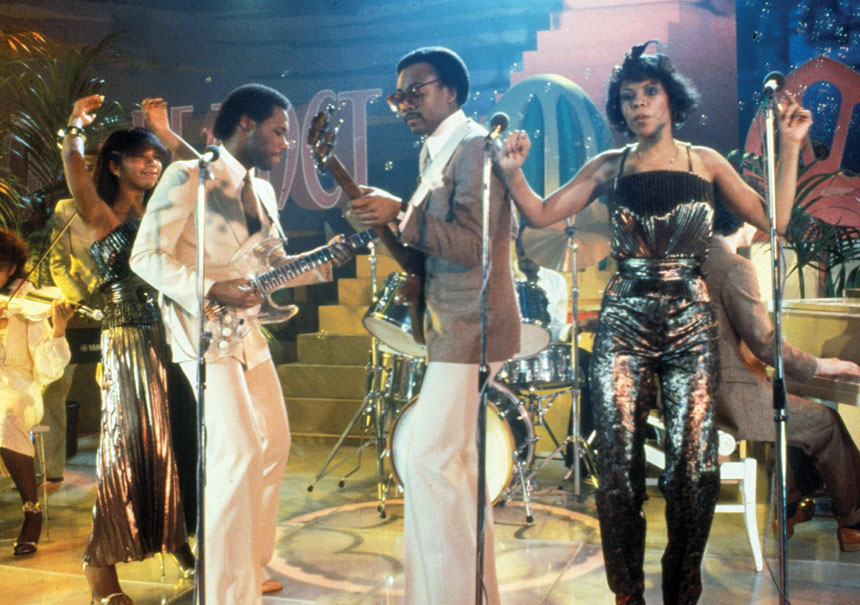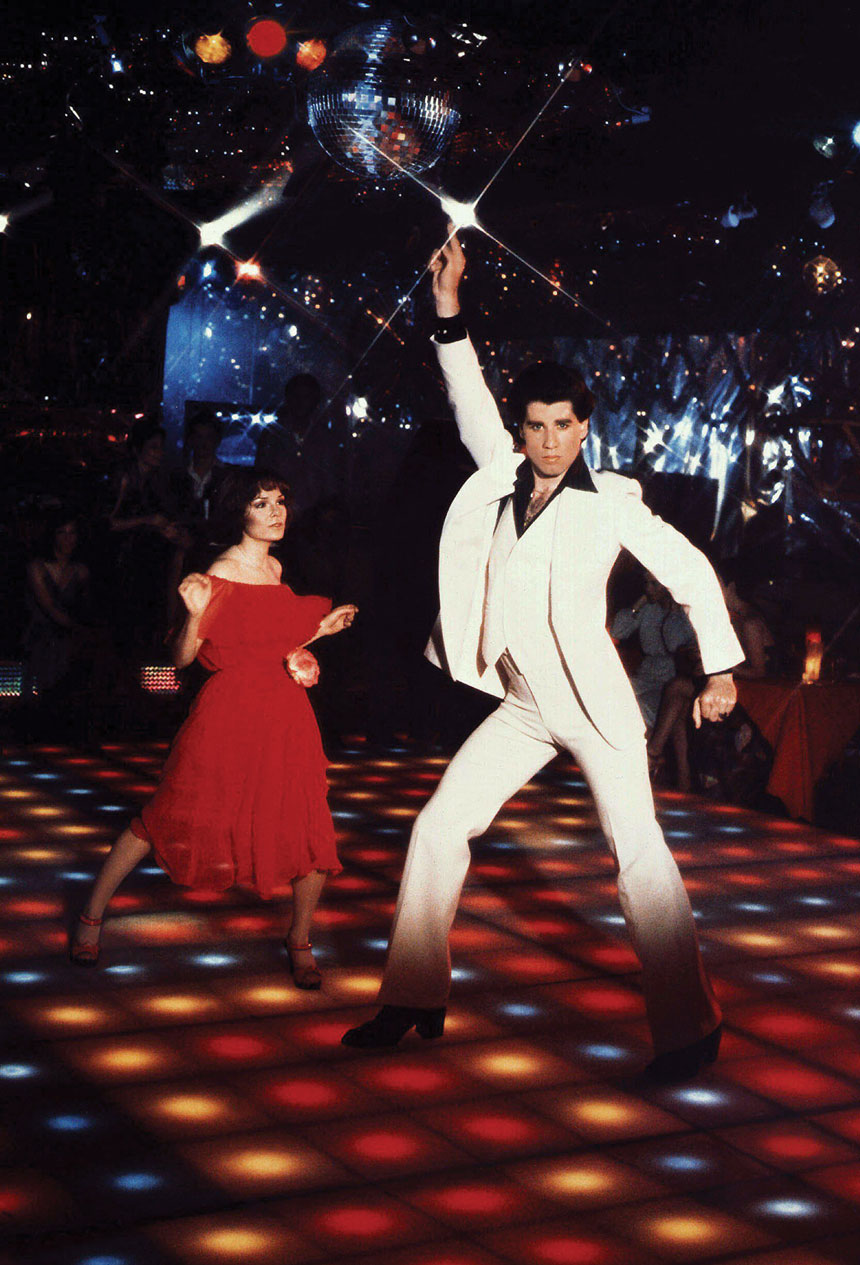Musical movements never happen overnight. Before a new style catches popular attention, it’s typically spent years growing and developing under the cover of darkness until it’s ready to take its moment in the spotlight. The early 1970s were a potent incubation period, with genres like punk, hip-hop, and funk all taking shape. But nothing lit up the dance floor like one sound that briefly seized the cultural moment so tightly that it has become inextricably linked to the decade. That sound was disco.
Disco has no identifiable birth date, but one can follow its development from earlier decades. One huge step in the sound coming to life was taken in 1970 when New York D.J. David Mancuso started hosting an ongoing slate of private parties at his home, which was known as The Loft. Mancuso’s Loft emerged as the center of a new dance culture that would spread out into more parties before taking hold in the clubs. The philosophy behind The Loft was one of inclusivity; the audience was blended, in terms of both ethnicity and sexuality. In that spirit, Mancuso focused on playing music that was celebratory and, more importantly, danceable.
As for what constituted the actual sound of disco, it was a brew pulled from a variety of regions and styles. Certainly Motown R&B was a predecessor. R&B’s cousin soul played a part, especially Philadelphia groups like The Stylistics (whose deployment of falsetto would influence The Bee Gees) and The O’Jays, who had a proto-disco hit with “Love Train” in 1972. Standing at the intersection of those two subgenres were The Temptations, who mined their dance-worthy psychedelic soul for bass-heavy hits like “Cloud Nine.” A union of musicians from Detroit and Plainfield, New Jersey, would result in the funk collective headed by George Clinton, Parliament-Funkadelic, whose deep grooves provided another stone in the disco foundation.

From the standpoint of American culture, the shift from the 1960s to the 1970s opened the door for new things in music, fashion, and more. While the counterculture movement was dying off and the Vietnam War dragged on, the country was plagued with economic insecurity that only grew worse with the Oil Crisis of 1973. But history has shown us that hard times are good for music. It’s not a coincidence that heavy metal, hip-hop, punk, funk, and disco would all be in ascendancy at this time. In the book Beautiful Things in Popular Culture, British sociologist and former rock critic Simon Frith noted: “The driving force of the New York underground dance scene in which disco was forged was not simply that city’s complex ethnic and sexual culture, but also a 1960s notion of community, pleasure, and generosity that can only be described as hippie. The best disco music contained within it a remarkably powerful sense of collective euphoria.” Soon, dance records that were spinning in clubs would find success in record stores and on radio.
On the Billboard charts, a number of songs that could arguably be classified as disco emerged as hits in the early 1970s. 1973 became a keystone year in disco’s popular success due to two particular releases. “Love’s Theme” was an instrumental composed by Barry White. It was first put on wax that July by White’s female back-up trio, Love Unlimited, on their album Under the Influence of … Love Unlimited. White also included the song on Rhapsody in White, an album by his 40-piece The Love Unlimited Orchestra, which would see release the following year. White put out “Love’s Theme” as the lead single for the record in November 1973. One month later, The Hues Corporation released their debut album, Freedom for the Stallion, which included “Rock the Boat.” Both songs from the winter of 1973 would reach No. 1 in 1974, signaling the mainstream beginning of the Disco Age.

Regardless of which songs were first to reach a wider audience, it was evident that disco had a place on the charts and was ready to blow up. Carl Douglas’s “Kung-Fu Fighting” and George McRae’s “Rock Your Baby” also hit No. 1, with “Rock” having the added distinction of being the first disco No. 1 in the U.K. The success of disco on the charts rolled on into 1975 with landmark tracks like Van McCoy’s “The Hustle”; the commercial breakthroughs of Donna Summer, who would become known as The Queen of Disco; and KC and The Sunshine Band, who notched five No. 1s and two No. 2s between 1975 and 1979.
Though the various groups and solo artists were all dance acts, they were actually quite musically diverse. But critics and musicians have argued that they had one major thing in common: the beat. In CNN’s documentary series The Seventies, Questlove of The Roots and The Tonight Show with Jimmy Fallon tried to articulate what stood out as the rhythm of disco. Discussing the 1976 song “Disco Inferno” by The Trammps, he said, “What we now know as disco, really starts with a band called The Trammps. The drummer, Earl Young, invents the idea of four on the floor with eight on the high hat, so everything is Bam! Bam! Bam! That’s the sound of disco.”
While the slew of songs hitting the charts was indicative of disco’s mainstream acceptance, it got even bigger as the music infiltrated film and television. In 1976, Nik Cohn wrote a piece for New York magazine called “Tribal Rites of the New Saturday Night,” which delved into the dance club scene.
Though Cohn would later tell The New York Times in a 1996 interview that much of it was fabricated, the article had a major effect at the time. High-powered music manager Robert Stigwood optioned Cohn’s story for film; the result was 1977’s Saturday Night Fever.
As it happened, Stigwood managed The Bee Gees. The band, which included brothers Barry, Robin, and Maurice Gibb, were already extremely popular pop artists. By the mid-’70s, they had shifted to a more dance-friendly sound (notably on 1975’s “Jive Talkin’“ and 1976’s “You Should Be Dancing”). The Bee Gees, who were already working on their next album, agreed to contribute those two songs and others they would craft (“Stayin’ Alive,” “How Deep Is Your Love,” “Night Fever,” and “More Than a Woman”) to the film’s soundtrack. They also wrote “If I Can’t Have You,” which was performed by Broadway star and recording artist Yvonne Elliman. The balance of the double-album soundtrack was created by adding tracks from acts like The Trammps, Kool & The Gang, and KC and the Sunshine Band, along with additional music and instrumentals by various artists, including an interpolation of “More Than a Woman” by Tavares. The result was one of the bestselling soundtracks in music history, with over 16 million albums certified sold in the United States; it topped the album charts for 24 consecutive weeks. The success of the Oscar-nominated film and the soundtrack elevated the profile of the genre to even greater, worldwide heights.

Between 1977 and 1980, roughly 22 songs that fit into the disco genre hit No. 1 on the Billboard Hot 100. These included obvious numbers like “I Will Survive” by Gloria Gaynor, as well as critically acclaimed pieces like “Don’t Leave Me This Way” by Thelma Houston, whose version of the Harold Melvin & the Blue Notes’ song won a Grammy for Best Female R&B Vocal Performance in 1977. Swedish hit machine ABBA struck disco-adjacent gold with the worldwide chart-topper “Dancing Queen”; the song hit No. 1 in America in 1977. The Bee Gees’ younger brother, Andy Gibb, held the No. 1 spot for seven straight weeks in 1978 with a tune written with his siblings, “Shadow Dancing.” Though Southern rock and soft rock were also having loads of success, disco was filling the clubs and having an impact on fashion, notably in terms of flowing dresses, platform shoes, open-collared men’s shirts, and suits that ranged from shiny to Saturday Night Fever white.
As happens with any popular movement, the success of disco begat a backlash. One major figure who fostered dissent with disco was Chicago D.J. Steve Dahl. Dahl had lost his job at WDAI when that station changed its format from rock to disco. After signing on at WLUP, Dahl essentially built his entire schtick around a hatred of disco. After promoting a few anti-disco events, Dahl helped engineer and participated in a promotion at Comiskey Park, home of the White Sox. Disco Demolition Night on July 12, 1979, encouraged fans to bring disco records to the double-header between the Sox and Tigers, where the discs would be blown up in center field.
The event got out of hand early when fans who couldn’t get into the sold-out affair broke into the stadium anyway. Beer, firecrackers, and albums rained on the field throughout the first game. After the crate of records was detonated between contests, thousands of fans rushed the field. Police were called, and eventually the White Sox had to forfeit the game (it’s the last American League behavior-forfeit on record).
While many, like Dahl, dismissed the circumstances of the event as harmless fun gone out of hand, others like Rolling Stone writer Dave Marsh expressed that a lot of the hostility toward disco included bigotry toward Blacks, Latinos, gay artists, and disco music fans. In the Bee Gees documentary How Can You Mend a Broken Heart, one of the security guards on duty that night pointed out that many of the “disco” records that fans brought were actually just records by Black artists.

Despite the anti-disco sentiment, a few days after the Comiskey Park incident, the Billboard charts reflected a week of peak disco. Seven out of the Top Ten songs were disco tracks: “Bad Girls” by Donna Summer (No. 1); “Ring My Bell” by Anita Ward (No. 2); “Hot Stuff” by Summer (No. 3); “Good Times” by Chic (No. 4); “Makin’ It” by David Naughton (No. 5); “Boogie Wonderland” by Earth, Wind, and Fire with The Emotions (No. 6); and “Shine a Little Love” by Electric Light Orchestra (No. 8). ELO wasn’t a traditional disco band but, like Blondie, released songs that employed the sound. Despite this high, disco was about to hit its inglorious low.
The damage Demolition Night had been unable to do was about to be dealt by another threat: new wave. On August 25, 1979, “My Sharona” by The Knack began a six-week run at No. 1. Critics typically lump The Knack in with new wave rock acts that also included multi-genre stylists like Blondie and Elvis Costello. Most new wave acts actually had punk origins, though, but the public antics of U.K. punks like the Sex Pistols led American record companies to create a new, safer label. After “My Sharona,” disco would still pop up on the charts for a while, but the shifting tides of taste and the fact that it was becoming cool to reject disco caused many artists to simply relabel themselves as dance.
MTV launched in August 1981. Though the new channel wasn’t available in every cable market in the country, its impact was immediate. MTV effectively killed disco for good in two ways. The first was the unfortunate reality that the network played very little in the way of Black artists in its early days. The second was that the channel embraced bands who were already making videos or working overseas (where the video clip format was already popular), resulting in a massive push for predominantly white, new-wave-related bands and English bands. Everyone seems to know that the first video played on MTV was “Video Killed the Radio Star” by The Buggles, but the next nine were from Pat Benatar, Rod Stewart, The Who, Ph.D., Cliff Richard, The Pretenders, Todd Rundgren, REO Speedwagon, and Styx. Black artists wouldn’t break through on the channel until the massive success of Michael Jackson and Prince over the following two years forced the network to catch up. As a result, some acts didn’t make the cut, and others, like The Bee Gees, had been placed in pop culture purgatory by the backlash-driven perception that they were no longer cool.
Over the ensuing decades, the pendulum swung back the other way. Today, disco culture is a staple of films and TV, as seen in everything from Boogie Nights to Pose to The Martian (Matt Damon’s character may have hated it, but Jessica Chastain’s loved it). The musical style has adapted and integrated into a variety of genres, including EDM and hip-hop, where sampled hooks are still regularly mined from disco classics. Package tours of disco artists continue to circulate. The influence has been felt in a number of popular songs of the past few years, among which are Daft Punk’s “Get Lucky” (which featured Nile Rodgers of Chic), “Uptown Funk” by Bruno Mars, and “Can’t Feel My Face” by the Weeknd.
That influence has also shown up in unlikely places; in the documentary series From Cradle to Stage, Dave Grohl stated that the drum sound he brought to Nirvana was inspired by disco acts like The Gap Band and Tony Thompson from Chic. So while disco may never have a proper, world-dominating comeback, even in the worst times it never truly went away. It’s probably fair to say that no matter how they try to kill it, disco will survive.
Troy Brownfield is the Post’s Executive Editor.
This article is featured in the November/December 2023 issue of The Saturday Evening Post. Subscribe to the magazine for more art, inspiring stories, fiction, humor, and features from our archives.
Become a Saturday Evening Post member and enjoy unlimited access. Subscribe now




Comments
Yes, I remember quite well. Every top band jumped onto the Disco Bandwagon. Some examples: KISS – I Was Made for Lovin’ You;” Steve Miller Band – “Swingtown;” Dr Hook – “When You’re in Love with a Beautiful Woman” and “Better Love Next Time;” Rod Stewart – Do Ya Think I’m Sexy.” I could go on and on. The music was great to dance to but it was time to turn the heat down on it and not totally off. It has its place even today.
I totally enjoyed your spot on article about Disco. I had a lot to do with the beginning of the disco movement in Honolulu on the beaches of Waikiki.
This is the best, most comprehensive feature I’ve ever read on the still largely misunderstood (and to some) controversial, disco. It was a natural progression of sound and style that eased its way in. I used to buy 45 records, and inadvertently bought disco, or its foreshadowing 45’s without realizing it. “Love Train” and “I’m Stoned In Love With You” are 2 from ’72 mentioned here.
I bought Barry White’s ‘Love’s Theme’ and the largely instrumental ‘TSOP’ in early ’74. At the time I think most considered it to be in the ‘Soul’ category. Same with the Hues Corporation’s “Rock the Boat.” George MacRae’s “Rock Your Baby.” (in hindsight) did have a lot of the incoming disco sound rather than soul.
A Gloria Gaynor hit (unfairly barely acknowledged) from 1974 was her brilliant, adult version of “Never Can Say Goodbye.” A beautiful fusion of soul and disco. “Kung Fu Fighting” was instant change-the-station time, like the overkill “Sweet Home Alabama.” Skipping ahead several years, “My Sharona” was far worse. It wasn’t disco or new wave, but was terrible. Fortunately, that wannabe whatever (?) group went away quickly, and the Eagles DRASTICALLY different and partially new wave inspired ‘The Long Run’ arrived shortly after!
It was a shame about the Comiskey Park destruction. But look at the 7 out of 10 Top Ten songs that followed! ELO was the successor to the Beatles, and I’m sure if they’d been around then, would have had songs incorporating the disco sound to some extent too. The “cascading downward” keyboard effect on “Shine A Little Love” is incredible.
Blondie, as mentioned, incorporated a little disco, but lightly. The Cars were the Beatles of new wave leading the cutting-edge way in, but disco must also be credited for the return of style for both men and women. The 80’s are credited for it, but it was really ‘Saturday Night Fever’ that lit the match, years before ‘Miami Vice’. In short, disco was the right sound at the right time, just like new wave that followed it. Both are WONDERFUL tune-out- the=present musical tonics now as they were then, and will continue to be.